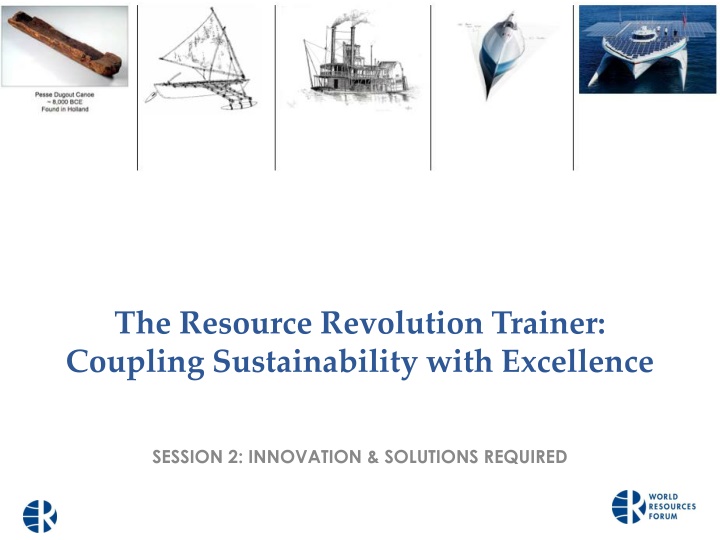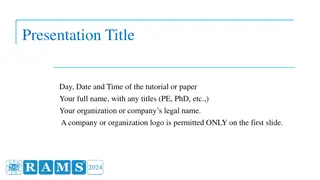
Resource Revolution Trainer: Coupling Sustainability with Excellence
Explore the innovations and solutions required for decoupling as a response strategy, turning risks into opportunities, and different types of decoupling processes. Learn about eco-efficiency guidelines, Vision 2050, and business-level decoupling in this insightful session.
Download Presentation

Please find below an Image/Link to download the presentation.
The content on the website is provided AS IS for your information and personal use only. It may not be sold, licensed, or shared on other websites without obtaining consent from the author. If you encounter any issues during the download, it is possible that the publisher has removed the file from their server.
You are allowed to download the files provided on this website for personal or commercial use, subject to the condition that they are used lawfully. All files are the property of their respective owners.
The content on the website is provided AS IS for your information and personal use only. It may not be sold, licensed, or shared on other websites without obtaining consent from the author.
E N D
Presentation Transcript
The Resource Revolution Trainer: Coupling Sustainability with Excellence SESSION 2: INNOVATION & SOLUTIONS REQUIRED
2. Innovation & Solutions Required: Decoupling as response strategy __________________ Building on IRP recommendations
Turning risks into opportunities Ray Anderson - Interface Gunter Pauli - Zero Emissions Research Initiative The Eureka! moment for the Zeronauts - new breed of innovator who is determined to drive problems such as carbon, waste, toxics and poverty to zero. (John Elkington 2012)
Resource Decoupling and Impact Decoupling
Three types of decoupling 1. Decoupling through maturation: Evolutionary process, overcoming inefficient techniques, building-up infrastructures, progressively reducing pollution 2. Decoupling through shifting burdens: Shifting to other territories more material intensive stages of product life cycles 3. Leadership - Decoupling through intentional productivity increase: Technological innovation, infrastructures for resource efficient & low material intensity manufacturing, alternative organizational cultures & consumption patterns
Eco-efficiency revisited Seven guidelines: Eco-efficiency: achieved through delivery of competitively priced goods and services that satisfy human needs and bring quality of life while progressively reducing environmental impacts of goods and resource intensity (WBCSD 1992, Changing Course) 1. reduce the material intensity of goods and services reduce the energy intensity of goods and services reduce toxic dispersion enhance material recyclability maximise sustainable use of renewable resources extend product durability increase the service intensity of products 2. 3. 4. 5. 6. 7.
Vision 2050 WBCSD Vision 2050 has made case for resource efficiency improvements of up to Factor Ten by 2050 Each unit of production produced using only 10 percent of its current resource inputs by 2050 Improvements of this nature also required to avoid dangerous climate change, as highlighted by the IPCC (AR4, AR5)
Decoupling @ business level Level of ambition required (Heck and Rogers 2014): Making 50%-80% resource productivity improvements (implies step-change, not mere incremental improvements) Ensuring 2 years or less payback period (involves making a convincing business case based on prototype financial scenarios) Developing a high productivity business model (address total performance , disruptive, key step between technological innovation & industrial transition phases of R-Revolution) Having ability to deliver at industry scale (resource productivity not relevant until it reaches massive scale)
Which of the Resource Revolution ambitions do you find most attractive from the perspective of your business in the short, medium or long term? _______________ DISCUSSION
New business models Epicentres of business model innovation (Osterwalder and Pigneur 2010) e.g. input substitution or output addition building on existing infrastructure Resource-driven e.g. used-product takeback for recycling Offer-driven e.g. product information provided via smartphones Customer-driven e.g. new revenue stream based on underutilized asset (e.g. for ecotourism) Finance-driven e.g. product-service systems (PSSs), product-as-service models (PASMs) Multiple epicentre-driven
Taking things to scale To take innovation to scale, your company needs to: Make it easy for customers to switch (little personal energy required, obvious benefits) Focus on the whole ecosystem (product with accompanying services and value chain) Provide committed champions (leaders) from business who will carry the innovation to the market
Call for business leadership Business leaders need to: 1. Recognize scope of the problem, incl fact that lots of variables are interacting simultaneously 2. Bring in people with experience, often require setting up teams with new or different skills 3. Model wherever possible, then test, using computer modeling to know whether complex processes and systems work
Call for business leadership Unilever s Paul Polman, UNEP Champion of the Earth Award Winner `15 Sustainable Living Plan (2010) - overall strategy with three goals of (i) doubling size of its business while (ii) reducing its environmental footprint and (iii) increasing its positive social impact. Climate - aims to halve the GHG impact of its deodorants, food, detergents and other products between 2010 and 2020. Water - One Rinse fabric conditioner, developed for handwashing laundry, reduced amount of water to rinse detergent from clothes by two-thirds. Saves ave 30 litres water per wash. One Rinse products now used in 12.5 million households worldwide. Adapting product portfolio to fit future of limited resources - drive growth in new markets.
Do you have clarity on what decoupling would mean for your business? What resources (e.g. land, biomass, energy, water, materials) does your business use most intensively? What areas could you prioritize for setting decoupling goals? What do you take from the Unilever case? _______________ DISCUSSION






















